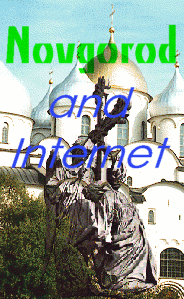Novgorod the Great: a name steeped in antiquity, and evocative of the
remotest past. In the course of its eleven - centuries - long history,
Novgorod shared in every major cultural event in the life of the Russian
people, and mementos of bygone years are plentiful both in and around it.
Hardly a church can be found in Novgorod that has not its legend, or does
not, at least, figure in some tale of old or in some work of hagiography. As
in Kiev, past events and occurrences of the day were recorded in Novgorod
since the eleventh century, by generations of chroniclers who left us highly
detailed and voluminous annals. Novgorod was a centre of high literary
culture; and manuscripts transcribed there form the greater part of the
remaining heritage of old Russian manuscript books.
Mikhail Lermontov (1814 - 1841 yy.), one of Russia's greatest poets, dedicated
the following lines to that city:
Hail, sacred cradle of the warrior Slavs!
Arrived from foreign lands, I gaze
With rapture at the gloomy walls
Through which the centuries of change
Passed harmlessly; where the Veche bell
Alone did serve the cause of freedom,
And then the end of freedom tolled,
And many a proud soul with it did fall...
Oh, telI me, Novgorod, are they no more?
Is not your Volkhov what it was before?
Old Novgorod's significance to Russian cultural history is exceptionally
great. Novgorodian painting was the first to attract the attention of art
collectors and art historians by its outstanding aesthetic merits.
Novgorodian frescoes made the public realize the value of all ancient
Russian art. Novgorodian church architecture, though simple in its outward
form, has an artistic impact of enormous power. Novgorodian manuscript
books, works of literature, legends, and bylinas brilliantly
exemplify the high literary culture of ancient Rus. Birch - bark documents
of the eleventh to fifteenth centuries, found by archaeologists in large
numbers, testify to widespread literacy among the population of Novgorod and
its territories.
And finally, having escaped devastation by Mongol - Tatar invaders, Novgorod
played a part of immense importance to the history of Russian culture as a
repository of the spiritual treasures of Kievan Rus, and as a guardian of
the ancestral cultural traditions of the Russian people.
After we had started our Internet site, we have recieved many letters with
questions about it. A month later the work on these pages was completed.
Now our site includes many books and images about ancient Novgorod life,
such as:
 Novgorodian Icon - Painting
Novgorodian Icon - Painting
 The Novgorodian Architecture Landmark
The Novgorodian Architecture Landmark
 Novgorod Icon Gallery
Novgorod Icon Gallery
and many others.
People from over the world explored with great interest information about
ancient Novgorod. The letters we receive contain pleasant remarks about the
work we're done. Now we are building a new section about Novgorod the Great
which is called "The Ancient Novgorod". We attend to build up more interactive
and beautiful pages with new features, such as frames, HotJava, etc. If
you visit our site some time later you'll be able to observe this.


 Novgorodian Icon - Painting
Novgorodian Icon - Painting
 The Novgorodian Architecture Landmark
The Novgorodian Architecture Landmark
 Novgorod Icon Gallery
Novgorod Icon Gallery